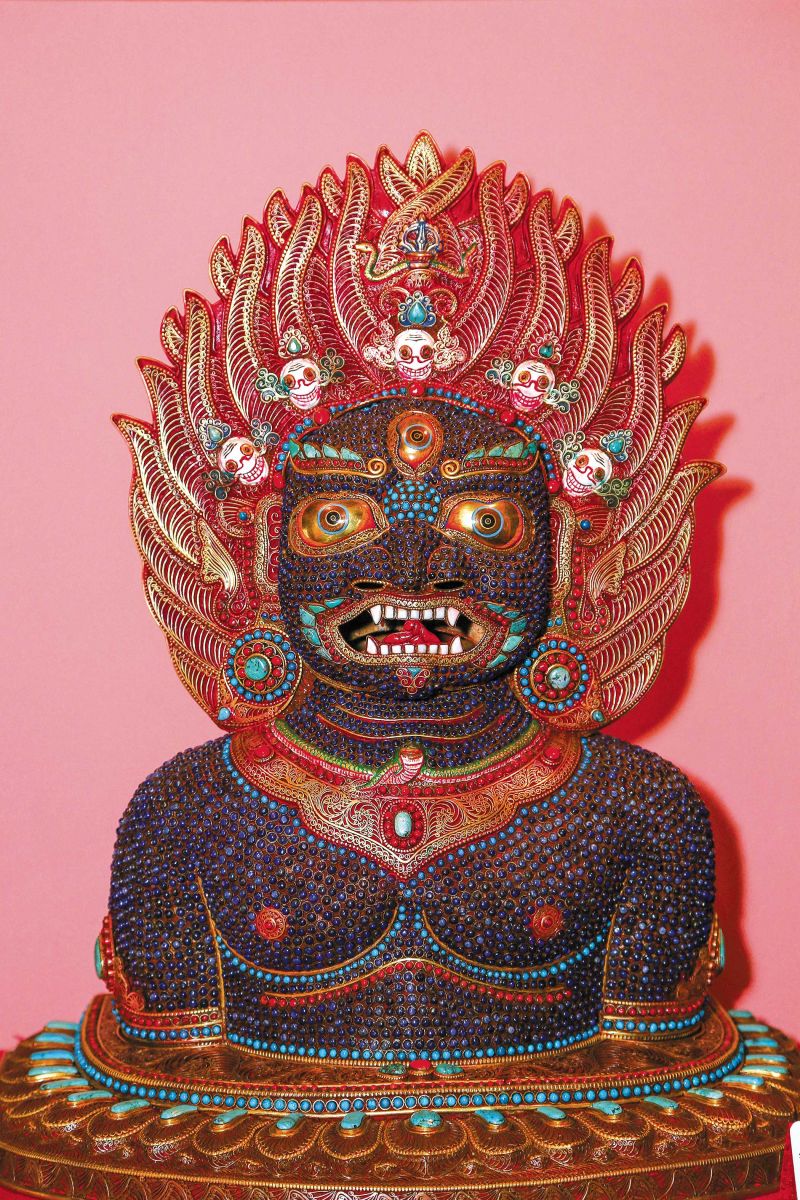The dim lighting and the long, narrow room that span the front of Patan Museum’s middle floor were an apt backdrop for the exhibit we had come to see. Art, definitely, but following an ancient path. The museum in Patan’s Durbar Square was the perfect place for such a collection to be displayed, as it was filled with objects that were newly made using a technique that had been passed down through generations.
Suraj Shakya is an artisan who learned his skills from his father. A lot of what he does is known as repoussé, and I was glad there were pictures included in the display showing him at work, as while I had heard of this art form, I knew little about it and would not have been able to explain it. Put simply, repoussé involves hammering a piece of metal from the reverse or back (the part of the image that won’t be seen) and in this way creating a form that stands out in relief on the other side. In this case, most of the images were faces, as Suraj Shaka is an expert at mask-making. After the shape has been formed, he then decorates the masks or statues with hundreds of tiny semi-precious stones, as well as brass, gold, or silver filigree. Bone is also used, for instance, to make the fearsome teeth that the figures are often baring.
I learn that this art of mask-making is called Khwaa-Paa in Newari, and that the family has been making art like this for generations, at least as far back as his great-grandfather. They are clearly an artistic family—his sister Sunisha Shakya, who is also explaining the exhibit to me, is a portrait artist. Their great-grandfather and grandfather were gifted artists who made gold and silver sculptures in their day, and worked on many of Patan’s monuments. The Khwaa-Paa mask-work was just one of the things they did. Suraj and Sunisha’s father, Purna Ratna Shakya, then devoted his life to mask-making, enhancing the traditional mask designs that he had learned from those who came before him.
 Suraj Shakya says that he believes he is now the only person continuing this specific art form as relates to masks: “If I stop it, nobody will continue this work.” And, while he does continue to make traditional pieces, he is also attempting to bring new elements to the work, such as animals, to keep it fresh and alive. Speaking to him and his sister, one realizes that at the end of the day, even something as beautiful as this is also a business: if people are not interested in buying it, the artist will be unable to continue his art; the practice will die out. These intricate and amazing works take a long time to make—just an example: when I asked, I learned that one small piece I was admiring took over two-and-half months to create—and astoundingly, the large pair of lions by the entrance took him three years! “This art is not just difficult to learn,” Sunisha explains. “It needs a lot patience.”
Suraj Shakya says that he believes he is now the only person continuing this specific art form as relates to masks: “If I stop it, nobody will continue this work.” And, while he does continue to make traditional pieces, he is also attempting to bring new elements to the work, such as animals, to keep it fresh and alive. Speaking to him and his sister, one realizes that at the end of the day, even something as beautiful as this is also a business: if people are not interested in buying it, the artist will be unable to continue his art; the practice will die out. These intricate and amazing works take a long time to make—just an example: when I asked, I learned that one small piece I was admiring took over two-and-half months to create—and astoundingly, the large pair of lions by the entrance took him three years! “This art is not just difficult to learn,” Sunisha explains. “It needs a lot patience.”
In addition to the masks, there are also mandalas, thankas (which I had never seen in metal before, though Suraj told me others make these, too) and other images that give the illusion of an aerial view of a temple. A particularly ornate dragon to the left of the entrance keeps drawing my attention; the details are just beautiful.
It’s work worthy of a museum, and is here being displayed in a museum—yet freshly made. It’s still, as of now, a living art form, and I hope it continues to be so for a long time. You can see it for yourself by calling 01-5003685 or emailing surajshakya1800@gmail.com









